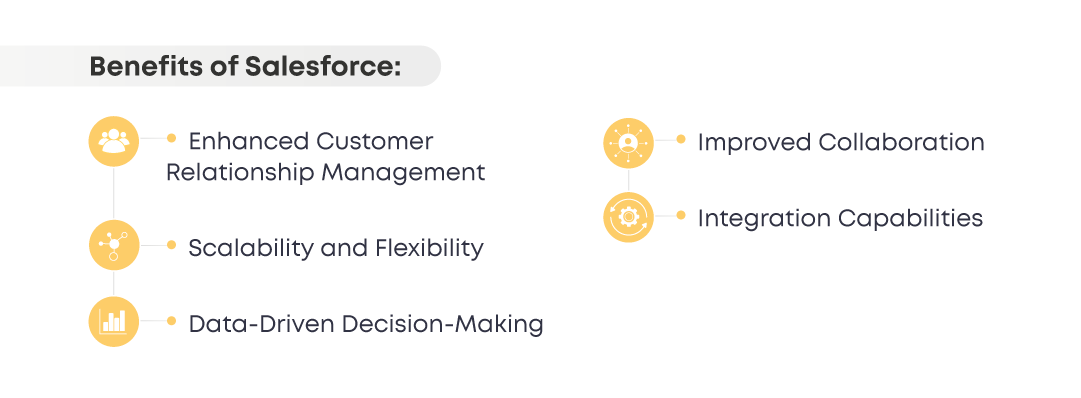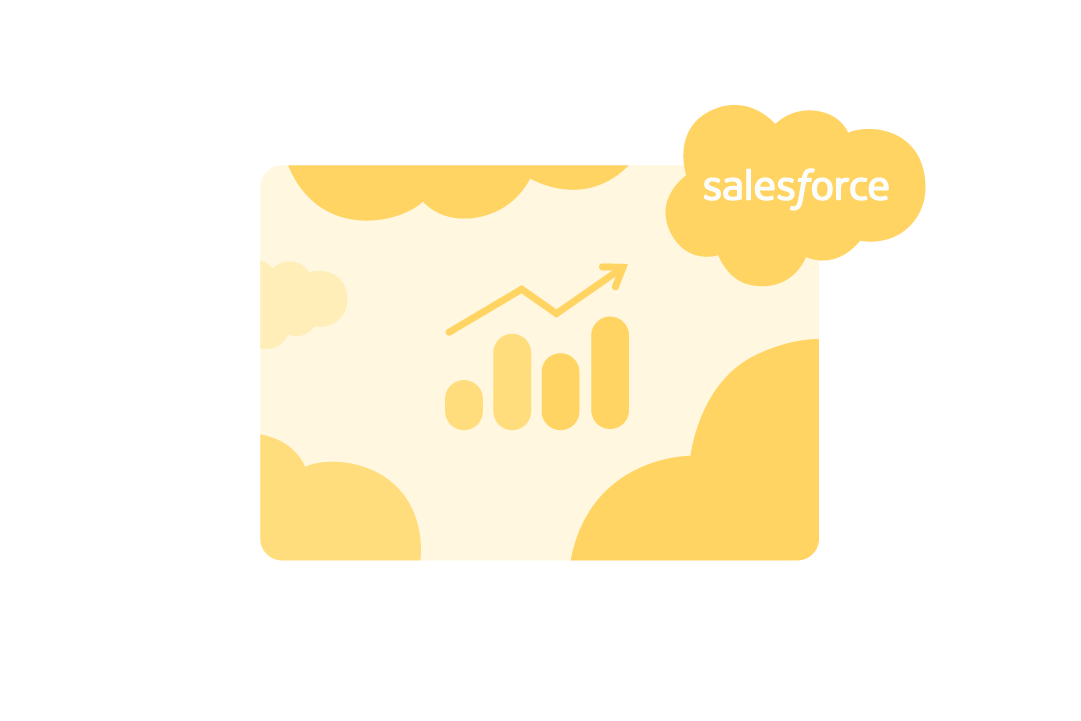Salesforce, originally built on a SaaS model, has evolved into a fundamental pillar of modern business infrastructure. Leading companies such as Amazon, Walmart, and Toyota use it for more than just its fundamental capabilities; they value its flexibility and unwavering commitment to consistent innovation. This enables them to adapt swiftly to market changes, foster better relationships with customers, and drive growth.
As we approach the end of 2023, it’s essential to stay updated with the newest advancements in Salesforce. While being knowledgeable about these advancements is crucial, the real effectiveness lies in implementing this knowledge. According to recent studies, businesses that adopt these modern practices experience a boost in productivity by more than 34%.
This article will provide insights into the latest Salesforce trends, focusing on Artificial Intelligence and Machine Learning among other transformative technologies. Discover how these transformations can be a game-changer for your business.
Let’s dive in.
What is Salesforce?
Salesforce is a cloud-based platform specializing in Customer Relationship Management (CRM). It empowers businesses to efficiently oversee customer data, sales operations, and marketing campaigns.
Within its suite of features and tools, Salesforce offers capabilities for enhancing customer relationships, such as customer segmentation, data management, and support services. Furthermore, Salesforce’s flexibility is amplified through a wide range of integrations with third-party applications and services, solidifying its position as a robust and adaptable CRM platform.
What are the Benefits of Salesforce?

Here are some compelling reasons to consider Salesforce for your organization.
Enhanced Customer Relationship Management
By consolidating data from multiple touchpoints, Salesforce offers a comprehensive 360-degree view of customer interactions. This enables personalized customer experiences based on data-driven insights, allowing businesses to customize their interactions and offerings. Consequently, these efforts lead to stronger customer relationships and loyalty, ultimately fostering long-term success and sustainable growth.
Scalability and Flexibility
Salesforce easily grows with your business. It can handle more data, users, and tasks without big changes. You can customize it to fit your industry, making it work perfectly for your unique needs. Also, Salesforce supports global operations and growth by offering language options, local data centers, and a worldwide network. This helps businesses go global and succeed in changing markets.
Data-Driven Decision-Making
Salesforce offers real-time data and reports, allowing you to stay updated on your business’s current status. This real-time insight supports quick decision-making based on the latest information. Moreover, Salesforce’s data tools and trends not only enhance decision-making but also provide a competitive edge by predicting future outcomes. This predictive capability is crucial, as 80% of business leaders rely on data to make informed decisions.
Improved Collaboration
Salesforce promotes cross-functional team collaboration, fostering seamless teamwork across departments. By facilitating the sharing of real-time information, Salesforce enhances transparency and data accessibility, encouraging informed decisions. Additionally, its robust project management capabilities streamline workflows and reduce manual tasks, optimizing resource allocation.
Integration Capabilities
Salesforce’s extensive integration capabilities empower businesses to create a cohesive ecosystem by connecting with a multitude of other software solutions. These integrations can span across various domains including, but not limited to, marketing automation, financial systems, analytics platforms, communication tools, and third-party applications. By doing so, Salesforce acts as a centralized hub, pooling data and functionalities from different systems into a unified interface.
Salesforce Trends in 2023
Here are the key Salesforce trends for 2023:
1. Customer-Centric Focus
With Salesforce’s advanced tools, like Customer 360, businesses can now seamlessly map customer journeys, tailoring interactions at every touchpoint. This helps businesses gain actionable insights into customer behavior to make informed decisions and deliver more relevant products and services.
According to recent data, 73% of customers expect companies to understand their unique needs and expectations, and 65% of consumers say they will remain loyal to companies that offer a more personalized experience. Salesforce’s data analytics capabilities enable businesses to continually improve the guest experience and remain competitive.
2. AI and Machine Learning
Businesses can gain a deeper understanding of customer behavior, market trends, and operational efficiency by leveraging AI insights. Before Salesforce Einstein Analytics, users had to move data from the software to a third-party business intelligence (BI) tool, usually via Extract, Transform, and Load (ETL). Now, with an AI-powered engine, this cloud-based analytics tool continues to be at the forefront of predictive analytics, keeping all the information in one central location. Adopting the AI and Machine Learning trend empowers businesses to achieve a competitive edge by making more informed and strategic choices.
Oril supports this trend through its expertise in developing custom AI-powered solutions on the Salesforce platform. Whether it’s implementing Einstein analytics or building intelligent workflows with Salesforce Flow, Oril ensures that businesses harness the full potential of AI and machine learning to drive growth, improve customer experiences, and stay ahead in the CRM scene.
3. Flow Orchestration
Flow Orchestration is an advanced workflow automation technique that allows businesses to create and manage complex, multi-step processes within Salesforce seamlessly.
It breaks intricate processes into bite-size, manageable tasks or “flows.” These flows can involve data updates, approvals, and even external integrations. They are designed using a user-friendly, visual interface, making them accessible to both developers and non-developers.
The flow orchestration enhances efficiency by automating repetitive tasks, reducing manual errors, and ensuring consistent processes. It improves collaboration among teams by facilitating the smooth flow of information and tasks across departments. Also, flow orchestration provides real-time visibility into process status, enabling businesses to make data-driven decisions.
4. Remote Work and Collaboration
As remote work gains traction globally, with 27% of its own workforce operating remotely as of May 2023, Salesforce has introduced new remote-friendly capabilities for its clients. Employees can now access the platform from home using a secure PIN provided by employers. This ensures seamless collaboration and project completion while aligning technology development with internal remote-work policies.
Additionally, Salesforce seamlessly integrates with third-party video conferencing tools, enhancing communication among employees, regardless of their physical location. Integrations with tools like Slack also facilitate instant messaging between colleagues worldwide.
Salesforce’s cloud-based architecture also empowers remote work by providing secure access to CRM data and tools from anywhere. The platform’s collaboration tools, including Chatter and Quip, further foster real-time communication and document sharing, enabling teams to stay connected and drive innovation regardless of their physical locations.
5. Digital Transformation
Salesforce plays a pivotal role in enabling this transformation. For instance, the platform’s Data Import Wizard simplifies the process of consolidating customer-related data from CSV files. By centralizing data in one place, Salesforce becomes the single destination for customer information. This not only streamlines decision-making but also enhances the overall user experience.
Furthermore, Salesforce’s extensive integration capabilities are pivotal for digital transformation. Consider the integration with DocuSign, which enables seamless electronic signatures, or the integration with Dropbox for efficient document management. These connections break down data silos, fostering data flow and process automation, thus significantly enhancing operational efficiency.
How to Leverage the Latest Salesforce Trends for 2023
Leveraging the latest Salesforce trends in 2023 is paramount for driving business growth and maintaining a competitive edge. Here’s how you can harness these trends effectively:
Predictive Financial Insights
Utilize Salesforce’s AI and machine learning capabilities, such as Einstein, to predict financial trends. For example, you can use the forecast sales outcomes to make agile business adjustments in response to economic fluctuations or changing consumer demands.
Streamlined Business Processes
Leverage Salesforce’s Flow Orchestration to automate complex business processes. This enhances visibility into your organization’s operations. It also allows you to monitor workflows and associated tasks efficiently, ensuring smoother business operations without the need for custom code.
Optimized Remote and Hybrid Work Models
With the ever-evolving work dynamics, Salesforce facilitates seamless communication for remote and hybrid teams. Fortunately, you can access Salesforce from home and collaborate on projects, enhancing the remote work experience and productivity for teams not based in the office.
Integration with Diverse Applications
You can integrate Salesforce with a wide array of applications to boost productivity. For instance, synchronize Salesforce opportunities with Quickbooks for streamlined invoicing, or connect Salesforce with Mailchimp to create targeted email campaigns based on audience segmentation, improving customer engagement.
What Is the Future of Salesforce?
The future of Salesforce holds remarkable promise as it evolves in response to technological advancements and changing business orientations. But surely, AI-driven personalization will be a hallmark, with Salesforce’s Einstein AI enhancing customer experiences through predictive analytics, anticipating needs, and providing proactive engagement.
Seamless integration will also expand the Salesforce ecosystem, streamlining workflows and improving data sharing across a wider range of third-party applications. This will bolster business efficiency and flexibility.
And as remote work continues to gain adoption, Salesforce will further support remote and hybrid teams, facilitating collaboration and productivity. Advanced analytics tools will offer deeper insights into customer behavior and market trends, and Salesforce’s global reach will continue to expand while offering localized solutions.
Conclusion
The Salesforce trends of 2023 offer a roadmap for businesses seeking to thrive in a rapidly changing industry. We’ve discussed personalization, AI, remote work, and more as key elements to embrace in this transformation. Now, businesses must adapt and innovate, leveraging these trends to enhance customer relationships and drive growth.
Fortunately, Oril stands as a trusted partner, equipped with expertise in Salesforce consulting and development, to guide your journey through these trends. So, take action today! Contact us to harness the power of Salesforce and ensure your organization remains agile, competitive, and customer-centric in the years ahead.





